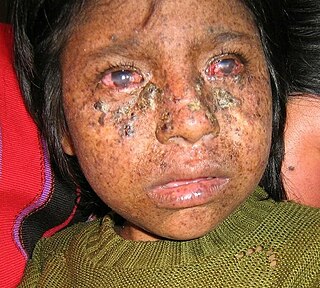General transcription factor IIH subunit 5 is a protein that in humans is encoded by the GTF2H5 gene. [5] [6]
General transcription factor IIH subunit 5 is a protein that in humans is encoded by the GTF2H5 gene. [5] [6]
The GTF2H5(TTDA) gene encodes a small (71 amino acid) protein that stabilizes the multi-subunit transcription repair factor IIH(TFIIH). TFIIH plays a key role in a major DNA repair process, nucleotide excision repair (NER), by opening the DNA double helix after the initial recognition of damage in one strand. This step is followed by excision of the damaged region to generate a single-strand gap, and then repair synthesis, using the undamaged strand as template, to accurately fill in the gap. Disruption of the GTF2H5(TTDA) gene in a knockout mouse-model completely inactivates NER. [7] In humans, mutation in any one of four genes can give rise to the trichothiodystrophy phenotype. These genes are TTDN1, XPB , XPD and GTF2H5(TTDA). [7]
GTF2H5 has been shown to interact with GTF2H2 [5] [8] and XPB. [5]

Xeroderma pigmentosum (XP) is a genetic disorder in which there is a decreased ability to repair DNA damage such as that caused by ultraviolet (UV) light. Symptoms may include a severe sunburn after only a few minutes in the sun, freckling in sun-exposed areas, dry skin and changes in skin pigmentation. Nervous system problems, such as hearing loss, poor coordination, loss of intellectual function and seizures, may also occur. Complications include a high risk of skin cancer, with about half having skin cancer by age 10 without preventative efforts, and cataracts. There may be a higher risk of other cancers such as brain cancers.

Nucleotide excision repair is a DNA repair mechanism. DNA damage occurs constantly because of chemicals, radiation and other mutagens. Three excision repair pathways exist to repair single stranded DNA damage: Nucleotide excision repair (NER), base excision repair (BER), and DNA mismatch repair (MMR). While the BER pathway can recognize specific non-bulky lesions in DNA, it can correct only damaged bases that are removed by specific glycosylases. Similarly, the MMR pathway only targets mismatched Watson-Crick base pairs.

XPB is an ATP-dependent DNA helicase in humans that is a part of the TFIIH transcription factor complex.

ERCC2, or XPD is a protein involved in transcription-coupled nucleotide excision repair.
Transcription factor II H (TFIIH) is an important protein complex, having roles in transcription of various protein-coding genes and DNA nucleotide excision repair (NER) pathways. TFIIH first came to light in 1989 when general transcription factor-δ or basic transcription factor 2 was characterized as an indispensable transcription factor in vitro. This factor was also isolated from yeast and finally named TFIIH in 1992.

Cyclin-dependent kinase 7, or cell division protein kinase 7, is an enzyme that in humans is encoded by the CDK7 gene.

CDK-activating kinase assembly factor MAT1 is an enzyme that in humans is encoded by the MNAT1 gene.

UV excision repair protein RAD23 homolog B is a protein that in humans is encoded by the RAD23B gene.

Cyclin-H is a protein that in humans is encoded by the CCNH gene.

Xeroderma pigmentosum, complementation group C, also known as XPC, is a protein which in humans is encoded by the XPC gene. XPC is involved in the recognition of bulky DNA adducts in nucleotide excision repair. It is located on chromosome 3.

DNA excision repair protein ERCC-6 is a protein that in humans is encoded by the ERCC6 gene. The ERCC6 gene is located on the long arm of chromosome 10 at position 11.23.

DNA repair protein complementing XP-G cells is a protein that in humans is encoded by the ERCC5 gene.

General transcription factor IIH subunit 4 is a protein that in humans is encoded by the GTF2H4 gene.

DNA excision repair protein ERCC-8 is a protein that in humans is encoded by the ERCC8 gene.

General transcription factor IIH subunit 2 is a protein that in humans is encoded by the GTF2H2 gene.

General transcription factor IIH subunit 1 is a protein that in humans is encoded by the GTF2H1 gene.

MMS19 nucleotide excision repair protein homolog is a protein that in humans is encoded by the MMS19 gene.

M-phase-specific PLK1-interacting protein is a protein that in humans is encoded by the MPLKIP gene. Patients with an inherited defect in both alleles of the gene suffer from trichothiodystrophy (TTD), a disease hallmarked by brittle hair and nails and usually by developmental difficulties as well. One patient carries a homozygous deletion of the whole gene area, which indicates that the gene is not essential for embryonic development. TTD can be diagnosed by the presence of tigertail-striped patterns in hair visible under polarised light microscopy, or biochemically by a reduced Cys content of the hairs. Only a minority of the TTD cases carry a MPLKIP defect: more frequently, the gene ERCC2 is mutated, which encodes a subunit of the protein complex TFIIH that is required for general transcription and for nucleotide excision repair of DNA damage.

Trichothiodystrophy (TTD) is an autosomal recessive inherited disorder characterised by brittle hair and intellectual impairment. The word breaks down into tricho – "hair", thio – "sulphur", and dystrophy – "wasting away" or literally "bad nourishment". TTD is associated with a range of symptoms connected with organs of the ectoderm and neuroectoderm. TTD may be subclassified into four syndromes: Approximately half of all patients with trichothiodystrophy have photosensitivity, which divides the classification into syndromes with or without photosensitivity; BIDS and PBIDS, and IBIDS and PIBIDS. Modern covering usage is TTD-P (photosensitive), and TTD.

In molecular biology, this protein domain represents Tbf5 which stands for TTDA subunit of TFIIH basal transcription factor complex, and Rex1 a type of nucleotide excision repair (NER) proteins. Nucleotide excision repair is a major pathway for repairing UV light-induced DNA damage in most organisms. The function of this protein is to aid transcription.